“The Great Dane is a loving Giant.“
The Great Dane belongs to the larger breed category, and it’s true that they grow faster. So, you have to be very careful while feeding them. Because you just cannot keep on feeding him without keeping any calorie tracking.
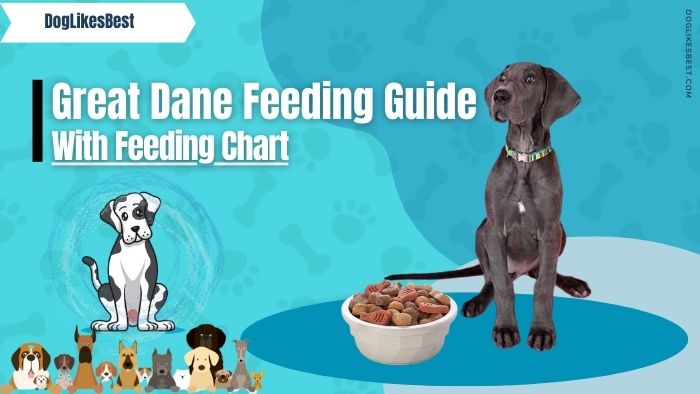
In this blog, we have covered all the basic feeding guidelines like How much should a Great Dane be fed? How many times Great Dane must be fed? The Great Dane feeding chart and schedule etc.
Let’s dig in to get a clear view of the Great Dane feeding chart/ feeding schedule.
Contents
How Much to Feed a Great Dane Puppy?
When your Great Dane puppy reaches the 6th week, he slowly began to eat kibbles and shows interest in having his puppy food. By this time, his body also gets used to solid food.
According to AKC “Feeding adult food will rob your puppy of important nutrients. Four feedings a day are usually adequate to meet nutritional demands.”
As your Great Dane puppy is at the growing stage, he will require more food intake since he has started eating solid foods. There are chances he will demand small kibbles and little munching during the daytime or evening.
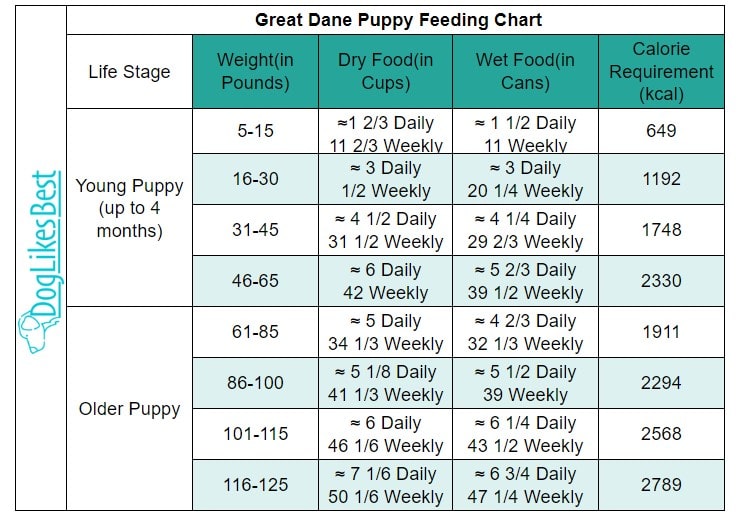
We also have an idea puppy requires thrice or four times meal a day. So, to give you a clear understanding of his eating schedule, we have attached a PDF of the Great Dane puppy feeding chart.
If we take the example of parenting a young Great Dane puppy whose weight is around 5 to 15 pounds. For them, it is recommended to feed 1⅔ cup daily (divide it into three to four equal proportions) and the calorie intake ratio should be around 649 kcal per day.
Similarly, an older Great Dane puppy weighs around 61 to 85 pounds. For them, it is recommended to feed 4 cups daily (divide it into three to four equal proportions) and the calorie ratio should be around 1911 kcal per day.
Keep one thing in mind, your Great Dane puppy requires food for proper growth. So according to their weight and body activeness, they will be demanding food. Feed him wisely.
Adult Great Dane Feeding Ratio
When your Great Dane turns 2, he enters into the adulthood zone. This doesn’t mean that you will keep on feeding more or increase the frequency of feeding food. This is because, in the case of adult Great Danes, more frequent feeding is not a good option.
So, if you think that by feeding more you are helping him to grow fast, then you are wrong. His feeding chart and frequency will vary and depend on his weight and activity level. You can check out the PDF of the adult Great Dane feeding chart for better knowledge.
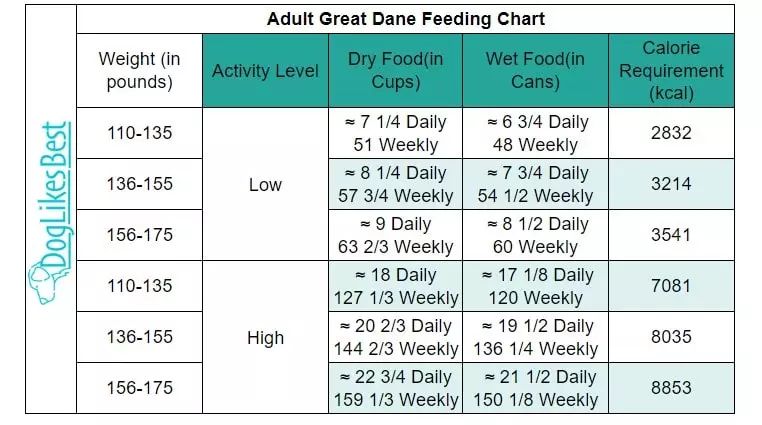
Let’s take an example, your adult Great Dane is highly active by nature like to go out for a walk at least twice a day, demands you to play with him, and is always take active participant in physical activities. In such a scenario, what should be his feeding ratio?
Well, let’s estimate that his weight is around 136 to 155 pounds and his activity level is high then it is recommended to feed him 20⅔ cups daily, and the calorie intake should be 8035 kcal per day.
On the other hand, if your adult Great Dane is carrying a similar weight but is less active. Then you have to feed him lower calories, and the feeding cup ratio will also gradually decrease as compared to the active one.
Senior Great Dane Feeding Ratio
“Large breed dogs are seniors earlier in life.”
As your Great Dane grows old, his food intake decreases and becomes less active. So, during senior hood, they require fewer calories, and the food you are serving should be 25% protein and 10% fat. In fact, for your reference, we have attached a PDF of the Great Dane Senior feeding chart, it will give you a clear view.
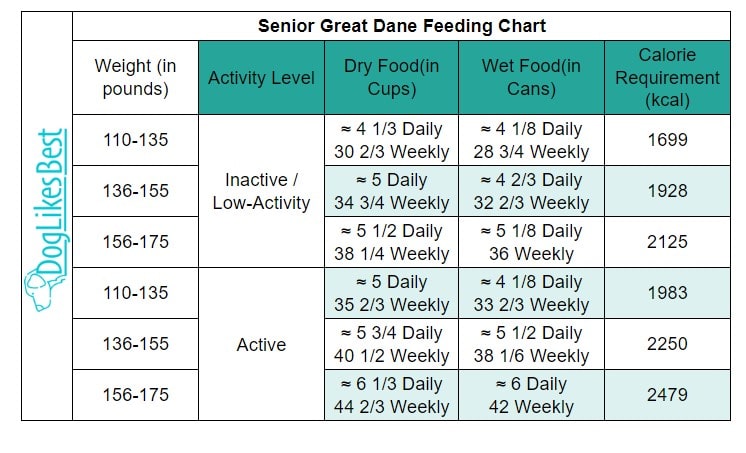
For instance, your senior Great Dane whose weight is around 110 to 135 pounds, with low activity level. It is recommended to feed him 4⅓ cups daily, and the calorie intake ratio should be 1699 kcal per day.
As they are not able to work out much and no physical activities take place. And if you keep on feeding them higher amounts of calories, it will lead to weight gain and bloating issues.
Great Dane Feeding Tips
After exploring the Great Dane feeding chart as per different life stages, weight. Now let’s have a look at the important factors like calorie intake proportion, weight bifurcation, activity level, and nutrient requirements for feeding the correct amount of food to your Great Dane.
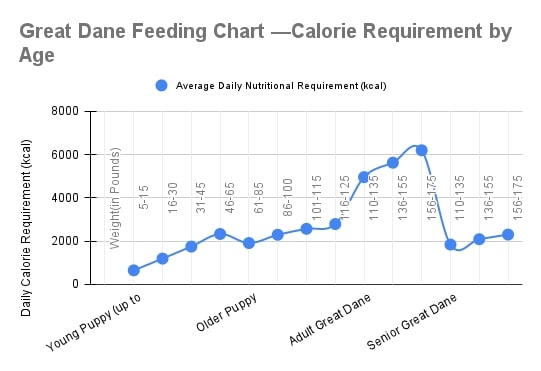
Well, one more thing to keep in mind while feeding your Great Dane is that they are prone to GDV/ bloating issues. So, you have to be very careful while feeding him to reduce the risk of GDV/bloating issues.
Let’s quickly have a look at the factors for fixing the feeding schedule for your Great Dane.
1. Calorie Intake Ratio
Generally, an adult Great Dane requires around, 3000 to 4000 kcal per day, but this ratio varies as per their weight, and activity level. In addition, make sure the food you are feeding should be of high quality and enriched with optimal nutrients.
Let’s explain to you with an example, if you have an adult Great Dane, and he is not an active one with a weight of around 136 to 155 pounds. Then calorie intake ratio should be 3214 kcal per day.
On the other hand, if he is an active one with the same weight, then his calorie intake will vary. He will be requiring more calories to satisfy his body’s needs.
2. Great Dane Weight
One of the factors is checking the weight while fixing the Great Dane’s feeding schedule. According to his weight and life stage, his feeding ratio is fixed, and you get an idea of how much food should be fed to the Great Dane.
PetMD states,”Great Danes are the tallest of the working breeds, standing at 28-32” in height. When they stand on their hind legs, they can be taller than most people. They are also very heavy, weighing 120-160 pounds on average.“
Before feeding him, it is important to keep a check on his weight. If your Great Dane is not provided as per his weight, it could lead to health issues. As Great Danes are prone to bloating issues, it’s become more important to keep a check on weight.
For instance, If you are parenting an adult Great Dane and is overweight, then we recommend you feed him a low-calorie ratio per day, and vice versa.
In this way, you will be able o maintain his weight and prevent him from getting over or underweight. Plus, other health issues will also be avoided, and your pup will be living a healthy lifestyle.
3. Great Dane Activity Level
The majority of the Great Dane enjoy brisk walking, jogging, aerobic activities, etc. Great Danes require daily exercise, warm-up, or kind of any physical activity to stay fit and healthy.
Like, if your Great Dane is in healthy state, then it is recommended to take him out for a walk or jog twice a time.
As per their activity level, you have to figure out his feeding ratio and fix the Great Dane’s feeding chart, to ensure his body is getting the correct amount of food on time.
For instance, you have an adult Great Dane, who weighs around 136 to 155 pounds. He likes to go out for a walk and also take part in physical activities. It can be said that your dog falls under moderate activity level, and accordingly you have to feed him. In such cases, the appropriate calorie intake ratio should be around 8035 kcal per day.
On the other hand, if your adult Great Dane is not an active one or falls under a low activity level, then his calorie intake ratio will vary from a higher one.
4. Nutritional Requirements
Looking after the nutrient ratio is important when feeding your Great Dane, whether he is in a puppy, adult, or senior hood stage. This is because feeding them a portion of high-quality food, enriched with all the essential nutrients, helps in the proper functioning of the body.
PetMD states, “Great Danes are large-breed dogs and should eat large-breed quality dog food.” So, feeding them a balanced diet, which is specially formulated for them to give them optimal nutrients.
Furthermore, watch out for human foods, which are safe for your Great Dane, so that you can feed it in small proportions. Plus, make sure you don’t feed him cooked bones, or food rich in fat or protein because it will lead to the rapid growth of the body.
Great Danes cannot afford rapid growth of the body because it directly impacts their joints, and lead to skeletal malformation. VCA states,”Bones that grow too quickly are less dense making the skeleton, including joints, weak. Exponential growth accompanied by increased body mass puts additional strain on bones and joints.“
It is advisable to feed a balanced meal as per Great Dane’s age, and weight requirements to avoid any severe health issues.
FAQs
How many times a day should you feed a Great Dane?
It is recommended you should feed your adult and senior Great Dane twice a day. Plus, their feeding schedule should be fixed, and try to keep 12 hours gap between the two meals. You can feed healthy treats in between, but it should be within the limit.
Can you overfeed a Great Dane?
No, you cannot and should not overfeed a Great Dane ever. This is because overfeeding leads to severe underlying health issues. Such as heart disease, diabetes, joint pain, stomach issues, reduced lifespan, etc. Always try to feed your Great Dane within the limit. And keep an eye on him, so that he doesn’t eat anything, which is not suitable for his health.
How much do female Great Danes eat each day?
The general feeding guidelines for female Great Danes are 5 to 8 cups daily. As they grow old, their feeding proportion varies, so according to her weight and age, you have to feed her.
How much to feed a Great Dane puppy?
Well, feeding proportion solely depends upon their age, weight, and developing stage. Generally, it’s recommended to feed thrice or four times a day to your Great Dane puppy. This is because their body needs are different during the growing stage, and they require more food.
What nutrients do Great Dane puppies need?
As we have an idea, puppies require extra attention and proper feeding as compared to adult dogs. This is because they are at a growing stage, and their body requires essential nutrients for better growth. Similarly, Great Dane puppies also require essential nutrients like protein, carbohydrates, fiber, fat, vitamins, and minerals.
What human food can Great Danes eat?
Some of the human foods that are safe to feed to your great Danes are Salmon, Chicken, Turkey, Eggs, Bread, Broccoli, Spinach, etc. You can feed human foods which are non-toxic for your Great Dane, but do not make it a habit or replace it with his regular meal.
Well, It’s a Wrap!
Now you know much about the Great Dane’s eating habits, schedule, and ratio for proper growth. Right?
Let’s quickly recall!
The Great Danes are a larger breed, so their feeding requirements are a bit different from the smaller ones. When they are at their puppy stage, they need thrice or four-time meals per day.
But when they reach their adult age, you just cannot keep on feeding them whatever he demands. This is because a higher intake of protein and fat can lead to rapid growth, and it will lead to joints issue in them due to their height and bone weight.
Always remember, Great Danes are a moderately active breed, so their calorie intake depends upon their weight and per day activity he is carrying out.
For your reference, you can download our PDF of Great Dane feeding charts we have bifurcated into three categories puppy, adult, and senior hood.
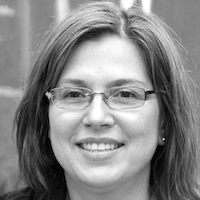
Julia is a Board Certified Veterinary Nutritionist, practicing veterinarian in a non-profit animal hospital and feline sanctuary located in Rochester, NY. She is also a full-time veterinary advisor at DogLikesBest. She focuses on writing healthcare-related topics including dog foods, treats, veterinary diets, food for specific healthcare features, etc. Moreover, any article on DogNeedsBest that has to concern feline health in any way, goes under her scrutiny before being published.


